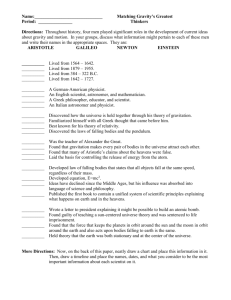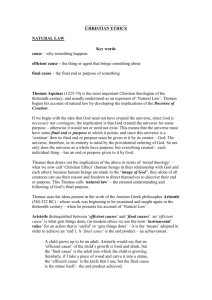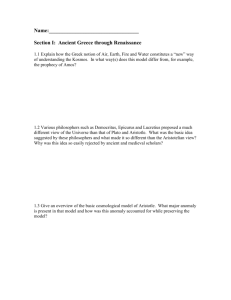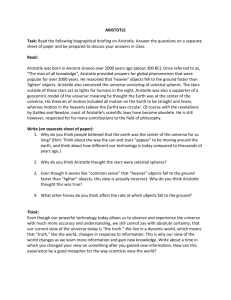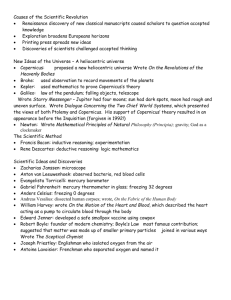CH 6 Sci Rev
advertisement
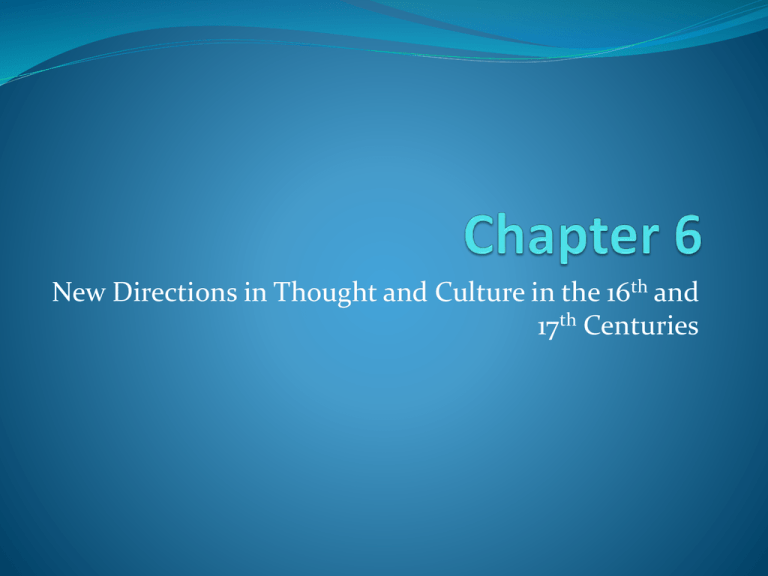
New Directions in Thought and Culture in the 16th and 17th Centuries Scientific Revolution An attempt to understand and explain how man and the world worked through scientific knowledge Astronomy Studying the motions and natures of heavenly bodies Cosmology Studying the creation, evolution, and structure of the universe Geocentric theory Ptolemaic belief that the Earth is the center of the universe and that the sun, moon, and all stars rotated around the Earth Galen Greek doctor who emphasized anatomy and cut open dead animals and recorded his findings; drawings still used Paracelsus German-Swiss botanist who gave zinc its name; established the idea of tria prima which included mercury (transformative/spirit), sulfur (binding/soul), and salt (solidifying/body) believed chemicals in nature could cure illness, which came from outside the body Andreas Vesalius Flemish anatomist and physician; wrote On the Structure of the Human Body founder of modern human anatomy and drew anatomical drawings after dissecting executed criminals and disproved Galen On the Revolutions of Heavenly Spheres Written by Nicolaus Copernicus and used to prove mathematics could explain how the sun was the center of the universe with Mercury, Venus, Earth, Mars, Jupiter, and Saturn revolving around the sun in perfect circular orbit. The moon revolved around the Earth and the stars were a fixed sphere surrounding the other celestial bodies. Attacked Ptolemy’s vision Nicholas Copernicus Published On the Revolutions of the Heavenly Spheres; disagreed with Ptolemy’s view that the earth was the center of the universe Heliocentric Theory Sun-centered theory of the universe Ptolemy Greek and Roman citizen of Egypt that worked as a mathematician, astronomer, geographer, astrologer, poet, etc. Wrote Almagest (physics of astronomy), Geography (map of the world), Quadripartitum (Four books on the horoscopes and astronomy) mapped 1000 stars Aristotle Student of Plato and Greek philosopher who taught Alexander the Great; taught about the physical world and the need for observation instead of Plato’s heavenly world of knowledge coming from a Universal Form; established his school the Lyceum; believed the star were unchangeable St. Thomas Aquinas Dominican friar and priest of the Roman Catholic Church who combined Aristotle’s ideas with the Church in the Summa Theologica. Believed that you could uncover the truth of the world (God) through reason and faith believed in spontaneous generation; natural law gave people certain rights that the government should not take away (life, to learn, worship, and reproduce) Gregorian Calendar Calendar established by Pope Gregory XIII of 365.25 days. Needed to offset the Julian calendar drift of ten days Scholasticism Idea of Thomas Aquinas and other Christian philosophers to solve questions of faith, reason, will, and the existence of God; method of learning using dialectical reasoning aka resolving contradictions, or “bringing together reason and faith in studies of religion Alchemy Form of chemistry from the Middle Ages and Renaissance fixated on the ability to transmute base metals into valuable metals; also finding an elixir of life Pope Paul III First pope of the Counter-Reformation and last pope of the Renaissance. Called the Council of Trent to reform the church and to define Church teachings and defining/unifying the Biblical canon Tycho Brahe Danish astronomer that worked with no telescope; established a geocentric model of the solar system where the sun and moon circled the Earth and the planets circled the sun. Observed a super“nova” that disproved Aristotle Johannes Kepler German mathematician, astronomer, and astrologer; focused on celestial physics Copernicus, and Aristotle’s ideas to create a physics based system to describe the rotation of the heavenly bodies. Worked with Tycho Brahe to obtain Brahe’s more accurate data so he could explain how the sun caused the motion of the planets. Founder of celestial mechanics and planetary motion in elliptical motion; explained how moon influenced the tides; Lutheran Laws of Planetary Motion Johannes Kepler’s three laws of the motion of the planets. 1.The orbit of every planet is an ellipse with the Sun at one of the two foci. 2.A line joining a planet and the Sun sweeps out equal areas during equal intervals of time.[1] 3.The square of the orbital period of a planet is directly proportional to the cube of the semi-major axis of its orbit. Ellipticals Kepler’s geometric explanation of the orbits of the planet The New Astronomy Kepler’s ideas on how astronomy worked and explanation of the orbit of Mars; explained away the retrograde of Mars with ellipses Isaac Newton Used Kepler’s laws of planetary motion and his own ideas on gravity to show Earth and celestial bodies were governed by the same laws; Wrote The Principia, and built the first reflecting telescope; explained how a prism works; helped to develop the Calculus; Three laws of motion Principia Mathematica Describes gravity as the one true force shared by all; identified that discrepancies must be noted and explained for good science; contains Newton’s Three Laws of Motion: I. Every object in a state of uniform motion tends to remain in that state of motion unless an external force is applied to it. II. The relationship between an object's mass m, its acceleration a, and the applied force F is F = ma. Acceleration and force are vectors (as indicated by their symbols being displayed in slant bold font); in this law the direction of the force vector is the same as the direction of the acceleration vector. III. For every action there is an equal and opposite reaction. Epistemology Branch of philosophy that is concerned with the nature and scope of knowledge. (What is it?, How acquired?, How do you know something?) Scientific method Techniques for investigating/acquiring knowledge; based on empirical/measurable evidence (Francis Bacon) Formulate questions/Observe Hypothesis Prediction Test/Experiment Analysis/Conclusion Inductive reasoning Using detailed facts to come to a decision, but not always the conclusion; reasoning to support a conclusion, but not ensure it i.e. all observed crows are black, therefore all crows are black Gravity Proved by Isaac Newton, but do I really need to define this? Attractive force between objects Divine watchmaker Developed by William Paley to explain God; States that if you found a watch on the ground you would infer someone made it because it had design, just like nature, the world, and the universe Francis Bacon English thinker who believed ideas based on tradition should be put aside; developed scientific method Novum Organum Francis Bacon’s work about the new instrument of science that details his new system of logic the scientific method; used inductive reasoning to find the cause of things Baconian Method The Advancement of Learning The first important philosophical book written in English; outlined Bacon’s ideas before Latin works New Atlantis Utopian novel by Bacon that envisioned the future of human discovery and knowledge; identified a future of utopian Bensalem island and its scientific institutes Deductive reasoning Reasoning from one general statement to reach a logical conclusion; identifies an accurate and specific conclusion i.e. all men are mortal, Socrates is a man, therefore, Socrates is mortal “Battle of the Books” Written by Jonathan Swift to satirize the battle between Ancient and Modern thought Portrays fighting authors and books trying to win supremacy of thought René Descartes Frenchman who wrote Discourse on Meth0d, which attempted to identify how you could know what was true; put aside all things except the one thing that could be proven “Cogito Ergo Sum, I think therefore I am.” Claimed mathematics was the source of all scientific truth because math was always true; used logic to move toward truths Founder of rationalism, the belief that reason is the chief source of knowledge Cartesian Dualism Descartes’ idea that the immaterial mind and the material body are two different types of substances that interact with each other Body could be divided up, the mind/soul could not be Mechanism All natural phenomena are caused by material things and principles and can be explained by mechanical laws; just needed to understand how something worked by uncovering why it worked Thomas Hobbes Wrote about English government and society; Strong supporter of the British monarchy and Charles I who was beheaded; Wrote the Leviathan Hobbes argued that natural law made absolute monarchy the best form of government Humans were naturally selfish and violent; could not be trusted to make decisions on their own; needed government that had power of a sea monster, or strong king to give people direction Natural law Law that applied to everyone and could be understood by reason; explained how government worked William Harvey English doctor who proved that blood flowed through the human body and that the heart pumped it John Locke English thinker who used natural law to affirm citizens’ rights and to make government answerable to the people; Explained the ideas of the Glorious Revolution in book Two Treatises of Gov. Gov. should be based on natural law, giving all people natural rights from birth of life, liberty, and right to own property Gov. should protect these rights and a social contract An agreement between rulers and the people; if ruler took away people’s natural rights, the people had a right to revolt and set up a new government First Treatise on Government Locke disproves Robert Filmer’s ideas that parents have authority over their children for creating them and that kings are sons of Adam and have authority over them Second Treatise on Government Explains the social contract Letters Concerning Toleration Locke’s letter to an anonymous friend explaining that religious toleration should be displayed for all Christians; argued that churches should persuade people to join, not threaten them to join Essay on Human Understanding John Locke’s idea book that explained human learning/understanding of the world Explained that all humans were born with a blank mind “tabula rasa/blank slate” and that the mind was filled through life experiences or empiricism Knowledge comes from sensory experiences Not innate knowledge that would be given to you through your parents Galileo Galilei Italian scientist who believed that new knowledge could come through experiments that were carefully carried out Challenged Aristotle’s idea that the heavier the object, the faster it falls to the ground Improved the clock and telescope Found evidence that the Earth revolves around the sun Developed water thermometer and his assistant, Evangelista Torricelli, used mercury to build the first barometer to measure air pressure Condemned by the Church and forced to withdraw many of his ideas under the threat of torcher/death Inertia Resistance of any physical object to change its state of motion or rest; defined by Isaac Newton in Principia Mathematica Dialogues on the Two Chief Systems of the World Written by Galileo to compare the Copernican system of the universe with the Ptolemaic system; this book led to Galileo’s charge for heresy Blaise Pascal French mathematician, physicist who studied the motion of fluids, developed mechanical calculators, and clarified the concepts of pressure and vacuum; also focused on geometry Jansenists Theory established by Dutch theologian Cornelis Jansen which emphasized predestination, deny free will, and maintain human nature is incapable of good; condemned by the Church Pascal’s Wager Pascal’s idea that there was more to be wagered on the existence of God than from atheism; rational people should live as though God exists “Rational God” Science based approach to understanding nature or reality Pensées Pascal’s defense of Christianity; helped to establish “Pascal’s Wager”; published posthumously Law of Probability Laws used to teach/study Quantum Mechanics and establish that the universe is not always exact Robert Boyle Irish scientist who proved that all substances are made up of basic elements that cannot be broken down Established modern chemistry and Boyle’s Law describing the inversely proportional relationship between the absolute pressure and volume of a gas if the temperature is kept constant within a closed system Royal Society of London Given a royal charter by King Charles II; advised the crown on scientific studies; originally a group of natural philosophers (scientists) who promoted knowledge and understanding via observation and experiment Pantheism Belief that all things encompass God and therefore are identical with divinity; Baruch Spinoza’s answer to Descartes’ Cartesian Dualism Marin Mersenne French theologian and “father of acoustics” identified oscillations in a stretched string and frequency Margaret Cavendish English aristocrat and scientist; wrote first science fiction works; influenced by Thomas Hobbes and supported his ideas of materialist philosophy with no incorporeal (like air) soul Maria Sibylla Merian Naturalist and scientific illustrator who studied plants and insect and made detailed paintings about them; illustrated butterfly metamorphosis and contributed to entomology Maria Winkelmann German astronomer who gave information to Royal Society of London which published/sold calendars and almanacs for her and her husband discovered Comet of 1702 Benedict de Spinoza Post-Cartesian philosopher and Rationalist who did not believe in sense perception to acquire knowledge, but instead should use intellect and geometry Wrote Ethics explaining that nature included God, not separated from God “Cunning folk” Early individuals accused of practicing magic “science” that would be helpful to people; searched for remedies to help people

